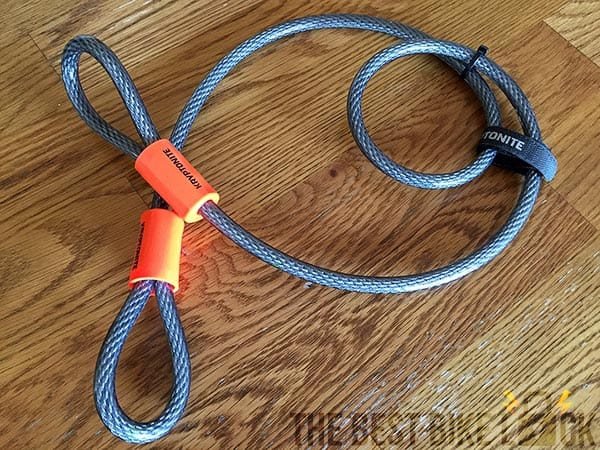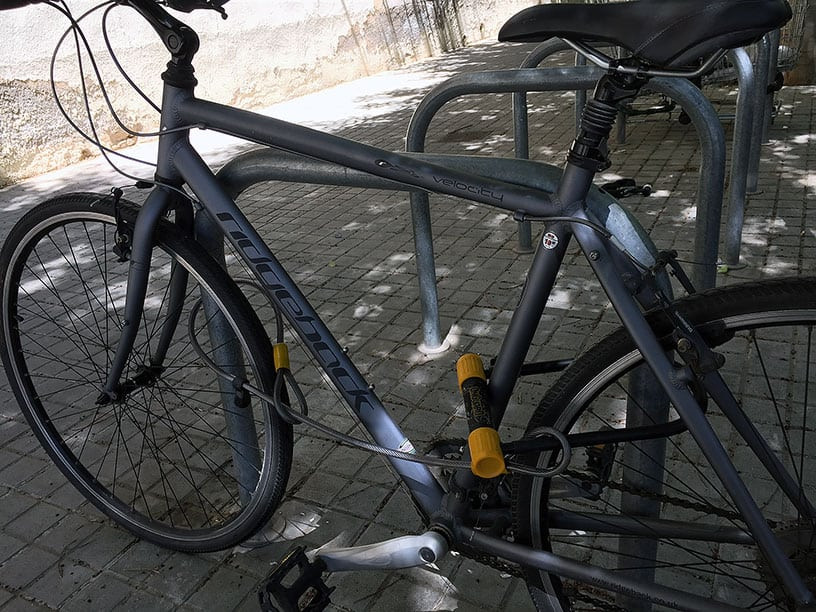Cable Bike Locks are often seen as a convenient and affordable option for securing your bicycle. They are lightweight, flexible, and easy to use, making them seem like a practical solution for everyday cyclists. However, despite their apparent advantages, cable locks are notoriously insecure and offer minimal protection against bike theft. If you are serious about keeping your bike safe, relying solely on a cable bike lock is a critical mistake.
If you’re considering buying a cable bike lock, it’s essential to understand their significant security flaws. Like many, you might think, “My bike isn’t expensive enough to be a target,” or “Surely, if shops sell them, they must offer some reasonable level of security.” This was my thinking too, right before my bike was stolen on the very first night I used a cable lock.
The harsh reality is that no bike is “too crappy” to be stolen, and retailers selling cable bike locks are not necessarily concerned with your bike’s safety. Don’t just take my word for it. Let’s examine some compelling evidence, including real-life examples and crime statistics, that clearly demonstrate why cable bike locks are simply not up to the task of protecting your bicycle.
Witness How Easily Thieves Defeat Cable Bike Locks
While any bike lock can be overcome with enough time and the right tools, the speed and ease with which thieves can defeat cable bike locks are alarming. The following videos illustrate just how vulnerable these locks are in real-world theft scenarios.
One video demonstrates the shocking flimsiness of some cable bike locks, showing a thief ripping a bike free with brute force alone. The incredibly thin strands of metal inside some cable bike locks offer virtually no resistance to determined thieves, making them more of a deterrent to honest people than actual security.
Another example showcases a thief using a small pair of cable cutters to quickly snip through a cable bike lock. Although the thief is apprehended before taking the bike in this instance, the video clearly highlights how easily and discreetly these locks can be compromised with minimal tools. This underscores the vulnerability of relying on a cable bike lock even in relatively public places.
Even thicker cable bike locks are no match for slightly larger cable cutters or bolt cutters. These tools, readily available and easily concealed, can make quick work of even the seemingly more robust cable bike locks. The speed and simplicity with which these locks can be defeated leave bike owners with a false sense of security.
Crime Statistics Speak Volumes: Cable Bike Locks and Bike Theft
Real-world crime data reinforces the anecdotal evidence and video demonstrations. Numerous studies consistently show a strong correlation between the use of cable bike locks and a higher likelihood of bike theft.
Data from the Harvard Police Department in 2011 revealed a stark reality: nearly two-thirds of stolen bikes were secured with cable bike locks. This statistic is not an outlier; similar findings are reported across various jurisdictions and studies. The overwhelming evidence points to cable bike locks being a primary factor in bike theft incidents, highlighting their ineffectiveness as a security measure.
The Inherent Weakness of Cable Bike Locks: Thin Strands of Steel
The very design of cable bike locks is their downfall. They are constructed from multiple thin strands of steel encased in a plastic tube. This design choice is what makes them lightweight, flexible, and inexpensive, as it uses less metal. However, the thinness of these steel strands is also the root cause of their insecurity.
These thin strands can be easily severed by common tools like cable cutters or bolt cutters. These tools effectively “chew” through the individual strands one by one, much like cutting through hair with scissors. The process is quick, quiet, and requires minimal effort, making cable bike locks an easy target for even novice bike thieves.
While thicker cable bike locks might appear to offer greater security, this is largely an illusion. The increased thickness primarily comes from a thicker plastic casing, not a significant increase in the amount of steel within. The core vulnerability – the thin steel strands – remains, regardless of the lock’s apparent bulk.
Secondary Security? Why Cable Bike Locks Still Fall Short
It’s crucial to understand that cable bike locks should never be used as your primary security. Primary security refers to the lock that secures your bike frame to a fixed, immovable object. While some cyclists consider using a secondary lock for added protection, even in this role, cable bike locks are a weak link.
Often, secondary locks are used to secure components like the front wheel or seat, either in conjunction with a primary frame lock or as a standalone measure for parts. Thin cable lassos are sometimes sold as secondary locks alongside more robust primary locks like u-locks. These lassos lack their own locking mechanism and are designed to be used with another lock.
 Kryptonite Kryptolok Series 2 cable
Kryptonite Kryptolok Series 2 cable
Personally, I am not a proponent of using these cable lassos, or cable bike locks in general, even as secondary security. They can be snipped through in seconds with small, easily concealed cable cutters, offering little real protection. Furthermore, their length and flexibility, often touted as advantages, can make them cumbersome to carry, use, and untangle.
 U-lock and cable lock
U-lock and cable lock
While a cable bike lock is arguably better than nothing, especially if you have quick-release levers on your wheels or seat post, it provides only superficial protection. A determined thief can easily overcome a cable bike lock to steal your wheels or seat.
Fortunately, there are much more secure and user-friendly methods for protecting your wheels and seat. Exploring dedicated wheel and seat locks is highly recommended before considering a cable bike lock for this purpose.
Conclusion: Ditch the Cable Bike Lock for Real Security
The most vital takeaway regarding bike security is this: avoid using a cable bike lock to secure your bicycle. If everyone stopped using these ineffective locks, bike theft rates would likely decrease significantly.
While cable bike locks are appealing due to their lightness, ease of use, portability, and low cost, they fundamentally fail at their primary function: preventing bike theft. No other lock type perfectly matches the convenience of a cable bike lock, but compromising on some of these practicalities is necessary to actually protect your bike.
Consider what aspects of cable bike locks are most important to you – is it weight, flexibility, or price? Then, identify which of these you are willing to sacrifice for genuine security. Utilize a comprehensive guide to finding a bike lock that balances user-friendliness with robust theft protection, moving beyond the false promise of cable bike locks.
[
